
Fundamentals of Carbonate Sequence Stratigraphy
Charles Kerans
Scott W. Tinker
Bureau of Economic Geology
| Design Objectives |
| Glossary |
| Credits |
| Back |
| Top |
| Exit |
 |
 |
 |
| The components of sequence stratigraphy |
| Cycles Cycle Sets Systems Tracts High Frequency Sequences Composite Sequences |
| Defining a hierarchy
of cyclicity is a fundamental but often poorly conducted step in constructing
a stratigraphic framework. The construction of this hierarchy must
be done as a conscious effort and must include data that many times
is considered non-standard for reservoir characterization. For example,
many carbonate core descriptions recognize cycle tops only where tidal-flat
lithofacies are present, leaving all subtidal cycles uninterpreted.
This can create an inconsistent view of the cycle hierarchy, with
a few very thick cycles and a few very thin cycles and no transitional
cycles. Establishing a stratigraphic hierarchy must entail looking
at both big picture and detailed data Building a robust sequence framework
does not necessarily save time up front, but instead gives a more
predictive and useful end result, and perhaps saves time and money
in the long run. The terminology advocated for cyclostratigraphy is a relative one. In two-dimensional sequence parlance, the terms applied here are composite sequence, high-frequency sequence, and cycles. In the one-dimensional world of cyclostratigraphy this hierarchy tends to be a numbered order system (1st = longest term, 5th = shortest term) (Fig. I). In most Precambrian through early Cenozoic data sets it is not possible to constrain the time element sufficiently to determine the average cycle duration. Still, most workers find that a first-pass evaluation of their cycle hierarchy in terms of this stratigraphic ordering is a useful exercise. As better resolution techniques for absolute dating of stratigraphic successions become available, it will be possible to improve the current technique of finding upper and lower bounding surfaces that are loosely constrained radiometrically and dividing the elapsed time implied by the number of cycles in the interval to arrive at a average cycle duration. |
|
|
| Tinker, JSR (1997) |
| Above: the hierarchy of cyclicity as preserved in carbonate settings, beginning with the cycle, the fundamental building block of carbonate stratigraphy. Cycles are usually on the order of 1-5 meters thick and are indicativeof predictable changes in water depth and water energies. Cycles bundled together - usually in groups of 2 to 5 - form cycle sets which can be interpreted across multiple facies tracts, shown here from shelf crest into a basin. Cycles sets (shown in yellow) are components of high frequency sequences (shown in blue) which may be made up of 3 to 7 cycle sets. High frequency sequences are components of composite sequences. |
| Transposed onto a analog outcrop (below), the same cycle history can be clearly identified. Beginning with a basal mudstone up through burrowed peloid packstone indicating a dominantly below-fair-weather wave base environment, to bedded peloid grainstones and grain-dominated packstones into ooid stratified grainstones above-fair-weather wave base, and finally, a fenestral algal laminated cycle cap. This rock record, approximately 15 feet thick, represents a single cycle. Geologically, there is great variability in permeability in these cycles: mudstones tend to be very tight, low permeability rocks while the higher-energy facies can have permeability variation that is quite significant. Understanding reservoir performance is possible by working out the architecture of the cyclicity and mapping out relative geometries of mudstones versus other carbonate rocks in a larger area. |
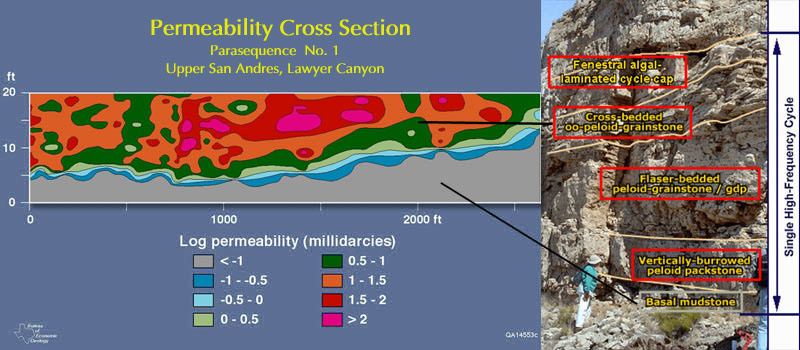 |
| Although perm varies greatly in carbonate rocks, cycle bases are commonly mud or clay rich, and very tight (low perm). Interpreting the correct cycle hierarchy becomes critical for understanding reservoir-scale heterogeneity. |
|
Process of Facies Description in Outcrop and Core
|
|
|
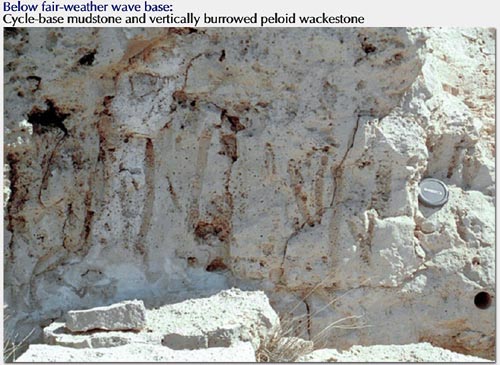
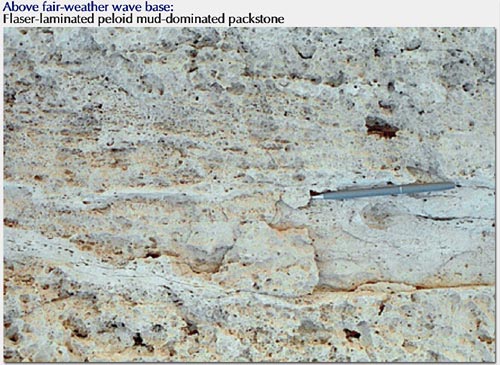
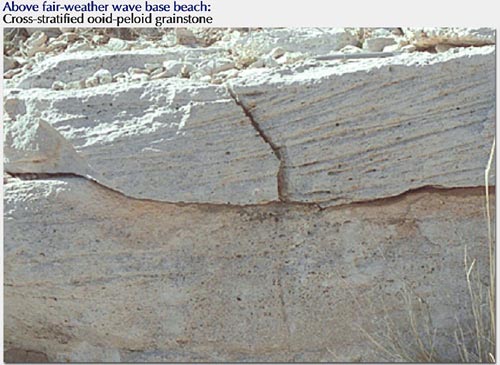
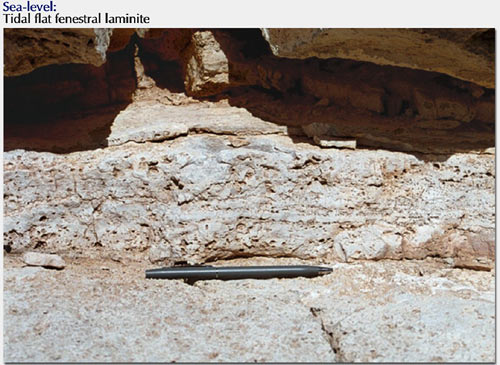
|
Definition Cycle Set: Bundles of cycles that show a consistent stratigraphic trend, either progradational, aggradational, or retrogradational (transgressive). Comparable to parasequence set. |
| CYCLE SETS |
|
Cycle sets are bundles of cycles that show a consistent trend, either progradational, aggradational, or retrogradational transgressive (above). Cycle set is analogous to Van Wagoner et als. (1990) parasequence set. In many reservoirs such as the Leonardian Clear Fork of the Permian Basin, this cycle set level is critical for reservoir framework construction as the individual cycles are of insufficient thickness/log response to be mapped (Holtz et al. 1992), and may not have impact on reservoir production. |
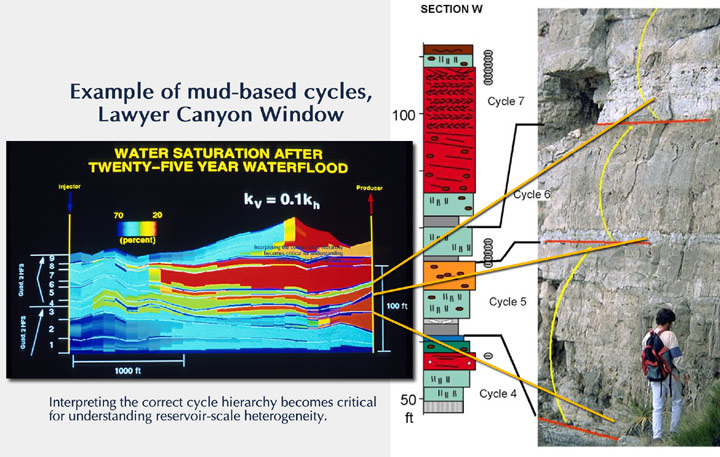
| Above: An outcrop photograph revealing four cycles. Mudstones at the base of each cycle are clearly visible in gray, with increasing grain composition (decreasing mud) upward to higher energy environments at the top, then repeating. This stack is a thinning upward succession of cycles that are part of a larger cycle set. Again, mudstones tend to interrupt vertical fluid flow in the subsurface as demonstrated in an illustration of flow simulation of an outcrop section. The water injector on the left (shown in blue) and the producing well on the right (fluids shown in red) illuminate key differences in architecture, with base cycles being very tight and higher energy grainstones being swept more efficiently. Architecture of the reservoir is controlled primarily by mudstones and grainstones which determine reservoir compartmentalization as well as the heterogeneity of the reservoir system. Though this example is relatively flat, in regions of greater accommodation such systems tend to prograde or backstep and reveal more complex stratal geometry. For this reason it is very important to work out the stratal geometry and reservoir archictecture to achieve an accurate 3-D reservoir model. |
HIGH FREQUENCY SEQUENCES By definition a depositional or composite sequence consists of "a relatively conformable succession of genetically related strata bounded at its top and base by unconformities or their correlative conformities" (Mitchum et al.1977). Mitchum and Van Wagoner (1991) recognized, through detailed stratigraphic analysis of core and well log data, that classic Vail-type depositional sequences originally delineated predominantly from seismic data are made up of multiple unconformity-bounded sequences. Mitchum and Van Wagoner (1991) proposed the term composite sequence for those depositional sequences that are comprised of multiple unconformity-bound sequences. The term high-frequency sequence was designated for these higher-frequency unconformity-bound sequences within the larger composite sequence. High-frequency sequences may have all of the attributes of composite sequences, including lowstand, transgressive, and highstand systems tracts and their component cycles and cycle sets.
COMPOSITE SEQUENCES Whereas high-frequency
sequences can be divided into systems tracts composed of retrogradational
and progradational cycle sets, systems tract delineation in composite
sequences uses comparable sets of high-frequency sequences, or sequence
sets (lowstand, transgressive, and highstand). Both high-frequency
and composite sequences are bounded by base-level-fall to base-level-rise
turn-arounds, which can be manifested in several ways. Bounding
surfaces of high-frequency sequences are identified on the basis
of 1) subaerial unconformities and karstification, 2) a turn-around
from progradational to retrogradational cycles (i.e., two-dimensional
cycle stacking patterns), 3) major basinward shifts or offsets in
the location of lithofacies tracts across a single surface, an extreme
example of which would be a downward shift of coastal onlap onto
the slope, and 4) analysis of systematic trends in the thickness
and lithofacies proportion of cycles, commonly referred to as stacking
pattern analysis (upward thickening and upward deepening cycles
during base-level rise followed by upward thinning and upward shallowing
to a sequence boundary during base-level fall).
|
|